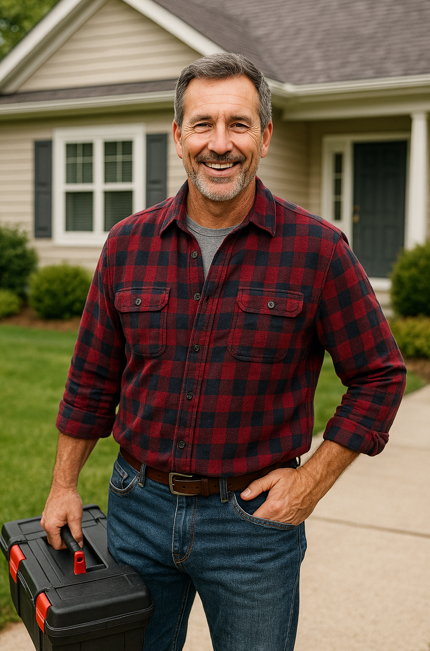👋 Hey There, Mike Sanders Here: Let’s Clear Up the Confusion on Efficiency
Howdy friends—Mike Sanders here. If you’re shopping for an electric furnace, you might've noticed something missing on the spec sheets: the AFUE rating. That’s because AFUE (Annual Fuel Utilization Efficiency) is designed for gas-burning equipment.
Electric furnaces, on the other hand, don’t have fuel to burn. They convert electricity directly into heat with no exhaust or combustion losses. That means they technically operate at 100% AFUE. But does that mean they’re automatically efficient in real-world use?
Not exactly.
Let’s break down what AFUE doesn’t tell you—and what you really need to consider when judging the efficiency of an electric furnace.
⚖️ What AFUE Actually Measures
AFUE is a fuel-efficiency metric. It tells you how much usable heat a furnace delivers per dollar of fuel.
Example: A 90% AFUE gas furnace turns 90% of the gas into heat, and loses 10% through the flue.
Since electric furnaces have no combustion process, there’s no vented loss. That’s why they all claim 100% efficiency. But hold your horses—because the real-world performance of your system depends on more than just the unit.
Learn more about AFUE from the U.S. Department of Energy’s guide.
🔥 100% Efficient Doesn’t Mean 100% Cost-Effective
Electric furnaces are 100% efficient at converting electricity to heat. But electricity costs more per BTU than natural gas in many regions.
Let’s do the math:
-
1 kWh = 3,412 BTUs
-
National average electricity rate: $0.15/kWh
-
So, 100,000 BTUs of heat = $4.40
Compare that to gas (at $1.50/therm) and you’ll see why efficiency alone doesn’t tell the full story. Efficiency must be viewed in context of your local energy rates.
To check your area’s energy prices, visit the U.S. Energy Information Administration.
💡 Duct Losses: The Hidden Energy Sink
Even the most efficient furnace loses effectiveness if your ductwork is a leaky mess.
According to ENERGY STAR, the average duct system loses 20-30% of airflow due to holes, leaks, and poor connections.
That means your 100% efficient furnace might only be delivering 70–80% of that heat into your living space.
Tips to improve duct efficiency:
-
Seal leaks with mastic or UL-181 tape
-
Insulate ducts in unconditioned spaces
-
Avoid sharp bends or crushed runs
This is why a professional install is so important—it’s not just about the unit, it’s about the whole delivery system.
📊 Static Pressure and Airflow Matter Too
Static pressure is HVAC-speak for how hard your blower has to work to push air through your ducts. High static pressure = low airflow = less comfort.
Electric furnaces with ECM (electronically commutated motors) can help maintain better airflow while using less energy.
Ask your installer to:
-
Test and balance static pressure
-
Size ducts appropriately for the CFM rating of your system
-
Ensure return air pathways aren’t restricted
For more airflow optimization tips, visit HVAC School’s guide to blower performance.
🌌 Smart Thermostats and Zoning: Stretching Efficiency
Pairing your electric furnace with a smart thermostat can reduce wasted run time and lower energy bills. Zoning systems (using dampers and multiple thermostats) allow you to heat rooms selectively.
Smart controls help you:
-
Use heat only when and where needed
-
Set schedules around occupancy
-
Monitor system runtime and efficiency
Even though the furnace itself doesn’t vary in efficiency, your usage patterns absolutely do.
💸 Comparing Long-Term Costs
A gas furnace with 95% AFUE may be cheaper to run in cold climates where gas is cheap. But in areas with:
-
Low electricity rates
-
No gas service
-
Solar panels on the roof
...an electric furnace may be cheaper to operate and easier to maintain.
It’s important to run the numbers for your own home. Check out DSIRE’s rebate database to see if incentives make electric heat more affordable.
🏠 Building Envelope and Efficiency
No furnace can overcome a drafty, poorly insulated house. If you want the most out of your heating system, invest in:
-
Attic insulation
-
Window upgrades
-
Air sealing (around doors, lights, vents)
Think of your furnace like a coffee maker. Would you pour hot coffee into a leaky cup? Fix the cup first.
🌬️ Final Thoughts: Judge the Whole System, Not Just the Unit
If you take one thing from this article, let it be this: Electric furnaces are 100% efficient by design, but real-world efficiency depends on your home’s setup.
Instead of comparing AFUE numbers, ask:
-
How efficient is my duct system?
-
Is my home insulated and sealed?
-
Will a smart thermostat or zoning help?
-
What are my electricity rates?
And most of all: will this furnace keep my home comfortable without costing a fortune?
If you’re ready to explore dependable models with clear specs, check out The Furnace Outlet's full collection of electric furnaces. Their team can walk you through sizing, install tips, and ductwork upgrades that make a difference.
Stay warm and stay smart,
Mike Sanders







